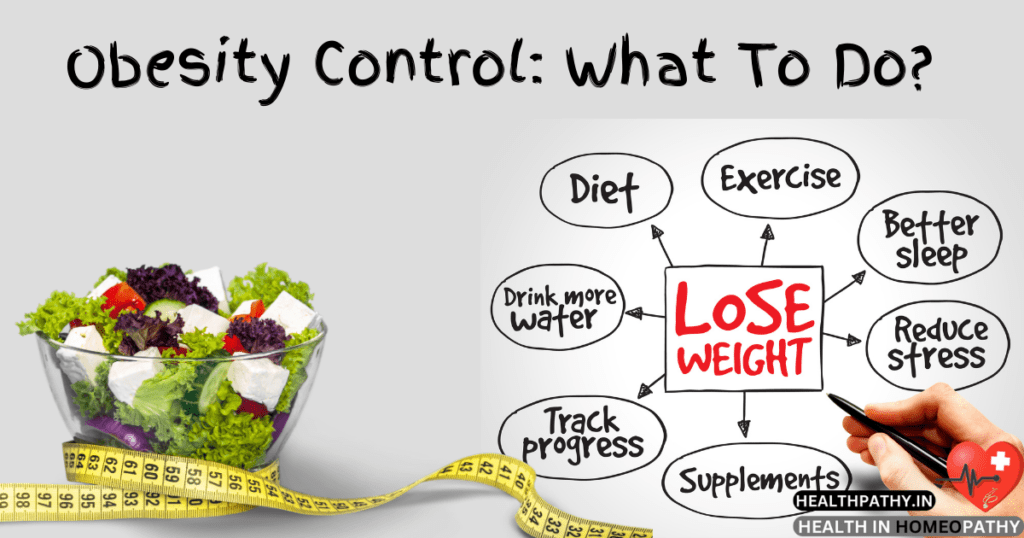In a state-of-the-art, fast-paced world, weight problems have become a giant health problem that affects thousands and thousands of humans. This article on Obesity Cures With Scientifically Proven Homeopathy delves into the complicated subject matter of obesity, offering a complete understanding of its reasons, sorts, and the signs and symptoms you have to watch out for.
- Obesity Cures With Scientifically Proven Homeopathy
- Unpacking The Weighty Issue: Understanding Obesity
- Contributing Factors of Obesity
- Types Of Obesity
- Symptoms Of Obesity
- Effective Homeopathic Cure
- Trusted Mother Tinctures Cure
- Other Safe Treatment Options
- Diet Tips For Prevention And Maintenance
- The Power Of Do's:
- Mastering The Don'ts:
- Conclusion:
- FAQ
- Must Read:
- Must Watch:


Unpacking The Weighty Issue: Understanding Obesity
In the state-of-the-art, fast-paced world, weight problems have become a giant health problem that affects thousands and thousands of humans. This article delves into the complicated subject matter of obesity, offering a complete understanding of its reasons, sorts, and the signs and symptoms you have to watch out for.
Contributing Factors of Obesity
The reasons for obesity are multifaceted. They encompass a mixture of genetic, environmental, and way of life elements. Poor nutritional conduct, loss of physical interest, and genetic predisposition can all contribute to this condition. Environmental factors like easy entry of high-calorie meals and sedentary life additionally play a widespread role.
1. Diet and Nutrition:
High-Calorie Intake: Consuming more calories than the body needs is a primary cause of obesity. diets rich in high-calorie, low-nutrient foods, consisting of rapid food, sugary liquids, and processed snacks, can result in weight gain.
Poor Eating Habits: Skipping meals, ingesting irregularly, or indulging in large element sizes can disrupt the body’s metabolism and contribute to weight problems.
2. Physical Activity:
Sedentary Lifestyle: Lack of physical activity, exercise, and prolonged durations of sitting or inactivity can result in an energy imbalance. Insufficient workouts prevent the body from burning extra energy.
Low Basal Metabolic Rate: Some individuals evidently have a lower metabolic rate; because of this, their bodies burn calories at a slower rate, making them more susceptible to weight gain.
3. Genetics:
Genetic Predisposition: Genetics can play a role in a person’s susceptibility to weight problems. Certain genes may affect the urge for food, metabolism, and the distribution of body fat. However, genetics alone no longer decide weight problems; they interact with environmental factors.
4. Psychological Factors:
Emotional Eating: Some humans turn to meals for comfort in the course of stress, tension, or depression, which can result in overeating and obesity.
Addiction and Cravings: Food addiction, particularly to high-sugar, excessive-fat meals, can contribute to excessive calorie consumption.
5. Environmental Factors:
Obesogenic Environment: Modern environments promote overeating and sedentary behavior. Access to bad meal options, marketing, and urban planning can impact lifestyle choices.
Socioeconomic Status: People with restricted resources can also have much less access to nutritious foods and opportunities for physical activity, raising the threat of obesity.
6. Medical Conditions:
Hormonal Imbalances: Conditions that include polycystic ovary syndrome (PCOS) and thyroid issues can affect metabolism and cause weight gain.
Medications: Some medicines, like positive antidepressants and corticosteroids, can pose a weight gain as a side effect.
7. Lack of sleep:
Sleep Deprivation: Poor sleep patterns, consisting of insufficient sleep or sleep disorders like sleep apnea, can disrupt hormones that alter the urge for food and metabolism, probably main to weight advantage.
8. Childhood Influences:
Early-Life Factors: Poor nutrition during pregnancy, early feeding practices, and adolescent obesity can set the level for weight problems in adulthood.
9. Cultural and Social Factors:
Cultural Norms: Cultural ideals about body size and nutritional customs can have an impact on consuming habits and bodily activity.
Social Network: Family, peer groups, and social circles can either help or discourage healthy lifestyle choices.
10. Stress and Mental Health:
Chronic pressure and intellectual fitness troubles can contribute to overeating and weight gain.
It’s critical to understand that weight problems are a complex interaction of genetic, environmental, and behavioral elements. Successful prevention and management of weight problems require a holistic approach that addresses those diverse causes. Tailored interventions, together with lifestyle modifications, dietary adjustments, physical hobbies, and, in some instances, scientific remedies, can help people acquire and preserve a healthy weight.
Types Of Obesity
Obesity is usually classified by measuring body mass index (BMI). There are three main types:
1. Class I Obesity (BMI 30-34.9): This is the mildest form of obesity, where someone’s BMI falls within the range of 30 to 34.9. Individuals with Class I obesity are reasonably obese. They might also enjoy a few fitness issues associated with weight problems; however, the dangers are exceedingly low compared to higher classes.
2. Class II Obesity (BMI 35–39.9): In this class, individuals have a BMI ranging from 35 to 39.9. Class II weight problems are considered severe. People with this stage of weight problems are at a higher risk of growing weight problems-related fitness troubles, which include diabetes, high blood pressure, and cardiovascular disorders.
3. Class III Obesity (BMI 40 or higher): Also known as morbid or extreme weight problems, Class III obesity involves a BMI of 40 or higher. This is the most excessive form of obesity, and individuals in this category face a considerably extended risk of life-threatening health issues. These may also consist of heart disorders, strokes, extreme sleep apnea, and certain cancers.
In addition to these primary types, weight problems can also be classified based on shapes, which include the distribution of body fat and the presence of underlying health situations. For example:
4. Android or Apple-Shaped Obesity: This refers to the accumulation of fats in general in the stomach location. It’s associated with a higher chance of coronary heart disease and type 2 diabetes.
Gynoid or Pear-Shaped Obesity: Here, fat accumulates specifically around the hips and thighs, which is generally much less dangerous in terms of fitness risks in comparison to above-belly obesity.
Metabolically Healthy Obesity: Some people classified as overweight won’t exhibit the everyday metabolic complications related to obesity. Their blood pressure, cholesterol levels, and insulin sensitivity are within a healthy range, regardless of their extra weight.
Understanding the styles of obesity is vital because it can guide treatment and control techniques. It’s crucial to note that the type based solely on BMI might not completely capture the complexities of an individual’s fitness, so a complete evaluation by way of a healthcare provider is vital for developing a tailor-made strategy to deal with weight problems.


Symptoms Of Obesity
Obesity can result in many physical and psychological signs. Some common signs and symptoms include excessive weight gain, increased fat around the abdomen, and difficulty with physical activities. People with weight problems also are at better risk of developing other fitness conditions, which includes sleep apnea, melancholy, and joint ache.
Certainly, here is a listing of common signs associated with obesity:
- Weight Gain: Gradual and excessive weight gain, frequently beyond a healthy range for one’s age and top.
- Increased Body Fat: A better percent of body fat as compared to lean muscle mass
- Difficulty Breathing: Shortness of breath and reduced lung capacity, particularly at some stage in physical activity.
- Fatigue: Feeling tired or lacking strength due to the strain of wearing excess weight.
- Joint Pain: Pain or discomfort in weight-bearing joints, which include knees, hips, and ankles, because of the added stress of extra weight.
- High Blood Pressure: Elevated blood pressure can boost the risk of coronary heart disease and stroke.
- High Cholesterol Levels: Abnormal blood lipid profiles, together with excessive degrees of LDL (bad) cholesterol and triglycerides.
- Type 2 Diabetes: Increased blood sugar levels and insulin resistance, leading to diabetes.
- Cardiovascular Issues: Increased danger of heart disease, coronary artery disorder, and heart attacks.
- Sleep Apnea: Disordered breathing throughout sleep, regularly followed by loud snoring and interrupted sleep.
- Depression: A better probability of experiencing despair and other intellectual health issues
- Fatty Liver Disease: Accumulation of fats within the liver, which can cause liver inflammation and scarring.
- Gastrointestinal Problems: Gastroesophageal reflux disease (GERD) and an increased threat of gallbladder ailment.
- Polycystic Ovary Syndrome (PCOS): Irregular menstrual durations, excess hair growth, and fertility problems in girls
- Infertility: Reduced fertility in both males and females
- Skin Issues: Obesity can result in skin issues such as chafing and skin infections in folds of excess pores and skin.
- Hormonal Imbalances: Changes in hormone levels can affect reproductive and sexual health.
- Decreased Quality of Life: A reduced overall quality of existence because of constrained mobility and other health headaches.
- Social and Psychological Effects: Stigmatization, lower vanity, and decreased overall well-being.
- Increased Cancer Risk: A higher chance of certain cancers, including breast, colon, and endometrial cancers.
It’s critical to observe that not all people with obesity experience all of these signs, and the severity of symptoms can vary. Additionally, people may have unique health concerns related to their particular circumstances. Obesity is a complicated situation that requires personalized management and assistance. If you or a person you already know is experiencing signs and symptoms of obesity, it’s important to seek guidance from a healthcare professional to develop a tailored plan for reaching a healthier weight and stepping forward in well-being.


Effective Homeopathic Cure
| Remedy | Indications |
| Calcarea Carbonica | Obesity with a tendency for excess fat in the abdomen. A constitutional remedy for reducing fat. Sweating on the forehead. Aggravated by using cold and dampness. Improved with the aid of warm temperatures and a dry climate. |
| Natrum Muriaticum | Obesity because of grief or emotional troubles. Aggravated via heat, better on the outside. |
| Amm Mur | Obesity with large buttocks, Fatty tumors. Fat on body, thin legs |
| Ferrum Met | Obesity with anemia, face puffy with pitting on flesh |
| Graphites | Obesity mostly in females with delayed menstruation. |
Trusted Mother Tinctures Cure
| Remedy | Indications |
| Fucus Vesiculosus Q | Obesity with thyroid dysfunction. Aggravated through heat. Improved with the aid of bloodless applications. |
| Garcinia Cambogia Q | Obesity with a tendency to overeat. Aggravated by way of wealthy, fatty ingredient, Better with a balanced weight loss plan. |
| Calotropis Gigantea Q | Obesity with a sluggish metabolism. Aggravated through humidity. Improved in dry conditions. |
| Spongia Tosta Q | Obesity with thyroid troubles and difficult breathing. Aggravated by cold, dry winds. Improved with warm drinks. |
| Cynara Scolymus Q | Obesity with liver and digestive troubles. Aggravated by way of rich, fatty foods. Improved with a light diet. |
Other Safe Treatment Options
Hydration: Drink lots of water throughout the day.
Regular Exercise: Incorporate daily physical activity.
Balanced Diet: Focus on end results, vegetables, and lean proteins.
Portion Control: Be conscious of element sizes.
Stress Management: Practice rest strategies.
Diet Tips For Prevention And Maintenance
A balanced weight-reduction plan is important for coping with obesity. Here’s a sample meal plan for breakfast, lunch, and dinner that specializes in nutrient-wealthy ingredients and element manipulation:
Breakfast: (Approx. 350-400 Calories):
- Scrambled Eggs with Spinach: Cook eggs with fresh spinach and a sprinkle of low-fat cheese for added flavor. (around 150–200 calories).
- Whole-Grain Toast: A slice of complete-grain bread with a light spread of natural peanut butter or almond butter. 70-80 calories
- Fresh Fruit: Enjoy a serving of fresh fruit like a small apple or a handful of berries. 30-60 calories.
- Green Tea or Black Coffee: Opt for unsweetened green tea or black coffee to kickstart your metabolism. Negligible energy (if unsweetened)
Lunch: (Approx. 400-450 Calories):
- Grilled Chicken Salad: Prepare a salad with grilled hen breast, blended veggies, cherry tomatoes, cucumbers, and a vinaigrette dressing. 250-300 calories.
- Quinoa or Brown Rice: Include a small portion of quinoa or brown rice for complex carbohydrates. 100-150 calories
- Fresh Vegetable Snack: Add sliced carrots, bell peppers, or celery sticks with hummus for an additional crunch. 20-30 calories
- Water or herbal Tea: Stay hydrated with water or natural tea all through the day. Negligible calories (if unsweetened)
Dinner: (Approx. 450-500 Calories):
- Baked Salmon: Enjoy a serving of baked or grilled salmon pro with herbs and lemon. 200-250 calories
- Steamed Vegetables: Pair the salmon with steamed broccoli, asparagus, or green beans. 50-70 calories
- Mashed Sweet Potatoes: Mash cooked sweet potatoes with a touch of olive oil and a sprinkle of cinnamon. 100-150 calories
- Mixed Berry Dessert: Satisfy your candy tooth with a bowl of combined berries like blueberries, strawberries, and raspberries. 50-80 calories
Snacks: (Approx. 410-150 Calories):
- Greek Yogurt: Choose low-fat or non-fat Greek yogurt for a protein-rich snack. 80-120 calories
- Nuts: A small handful of unsalted almonds or walnuts can provide healthful fats. 160-200 calories
- Sliced Veggies: Keep sliced cucumbers, bell peppers, or cherry tomatoes for quick, low-calorie snacks. 20-30 calories
Remember that portion control is important for managing obesity. Pay attention to your body’s hunger cues and practice mindful eating. Additionally, visit a healthcare expert or a registered dietitian for personalized guidance and to tailor a meal plan that fits your unique needs and dreams.
From Do’s to Don’ts: Transforming Your Life for the Better
The Power Of Do’s:
- Follow a well-balanced weight-loss plan.
- Engage in regular bodily activity.
- Monitor your development and seek advice from a healthcare professional.
- Manage stress through meditation or relaxation.
- Stay hydrated with water and natural healing teas.
Mastering The Don’ts:
- Avoid overeating or indulging in high-calorie junk food.
- Avoid skipping food, mainly breakfast.
- Don’t rely on bad diets for brief fixes.
- Don’t neglect portion control.
- Don’t avoid medical recommendations for obesity control.
Conclusion:
Obesity control calls for a holistic approach related to lifestyle changes, nutritional modifications, everyday workouts, and, in some instances, homeopathic remedies. It’s vital to consult a healthcare expert to create a customized plan tailor-made for your specific needs and to screen your development successfully. Homeopathy, when used as part of this comprehensive strategy, can aid in addressing the underlying causes and promoting overall well-being.
This article is step one in a series with the intention of providing exact statistics on obesity and its effect on fitness, weight control, and prevention techniques. Stay tuned for the approaching articles in an effort to explore those topics intensively.
FAQ
Must Read:
Scientifically Proven Health Benefits Of Meditation
Scientifically Proven Health Benefits Of Family
Must Watch:
Holistic Healing_Homeopathy vs Ayurveda
Saturday 26 April 2025 10:10:59:PM
- Acromegaly Cures With Scientifically Proven Homeopathy - 8 February 2024
- Acidity Cures With Scientifically Proven Homeopathy - 1 February 2024
- Appendicitis Cures With Scientifically Proven Homeopathy - 27 January 2024


